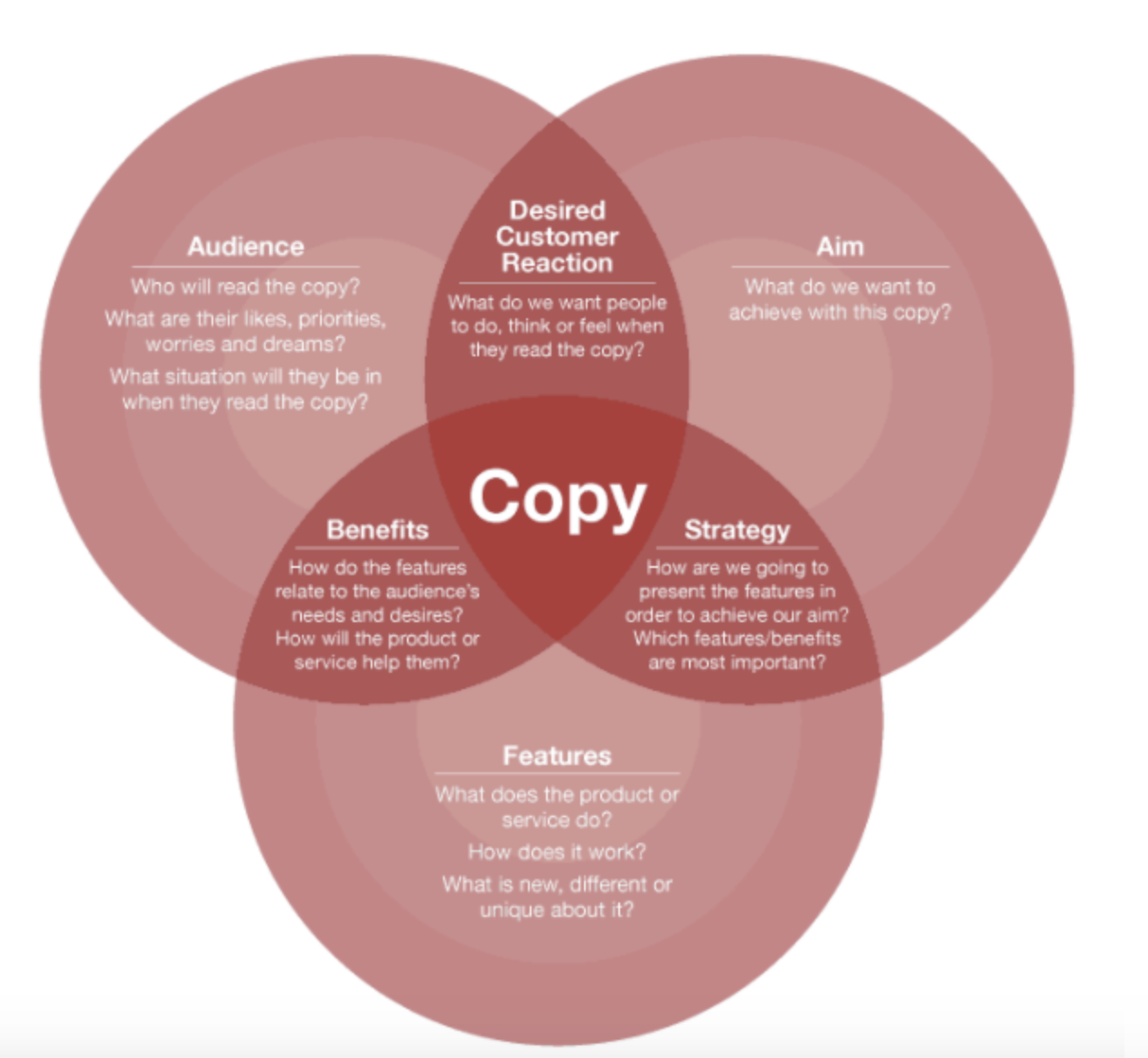
What is Copywriting?
Copywriting, at its core, is the art and science of strategically using words to persuade the reader to take action.
Copywriters are, in essence, persuasion artists.
Your challenge is to persuade the reader - to sign up for your newsletter or blog, to download a premium offer, to request a demo or quote, or to buy.
In this blog article, we will dive into why great copywriting is so impactful to the success of a business, and how you can apply its basic principles to tune up your assets and convert more of your audience.
You can also use this as a guide for what to look for when hiring for a great copywriter.
Why is Copywriting Important?
Copywriting is one of the most essential skills needed to fuel successful marketing campaigns.
Good copywriting is like having another salesman that works for you 24 hours a day, 365 days a year.
While a sales team contacts customers one at a time; a copywriter reaches all of them at once through emails, ads, sales letters, blog posts, and more.
Good SEO, design, and content marketing are important elements of a comprehensive digital strategy, but if you can’t convince someone to take action once they’re on your site - what does the traffic really do for you?
Compelling copywriting on your site and digital assets allow your business to turn more of those visitors into actual paying customers.
The Bottom Line
Generic writing that lacks emotion will fall on deaf ears and will struggle to generate any results.
On the other hand, if you can leverage your writing to tell a compelling story while convincing customers of the need for your product or service, you’ve opened up the floodgates to more sales opportunities and business growth!

Elements of Persuasive Copywriting & How to Put It Into Action
Copywriters Are Writers; But Writers Are Not Always Copywriters.
Let me start by saying that a writer is NOT the same thing as a copywriter.
It doesn’t matter if you’re a world-class wordsmith or a literary genius. Great copywriting at the end of the day isn’t just pure talent - it’s following a set of principles and tactics.
If you can’t effectively move readers through the proper sequence of steps and ultimately convince them to buy or take action, your conversions are going to suffer.
While you can hire a writer for often 35-45k, a skilled copywriter is usually going to cost your business a lot more, and they will be worth every penny.
Their ability to persuade others to buy and to use their words to act as your 24/7/365 salesperson means more consistent revenue growth for your business. Their work can be used to influence sales for years to come, even if the copywriter is no longer with the company.
So when looking to hire a copywriter, you will need to make sure you ask them how they define copywriting and what makes a piece of copy persuasive?
How do they structure their content to be persuasive? Do they follow any formulas?
If they can’t readily answer that or provide a specific example or a sample of their work that demonstrates this skill, then they aren’t an experienced copywriter.
Now, it doesn’t mean they can’t become a great copywriter - but it does mean they will have to learn this skill. And that can take some time; so you need to evaluate whether you are willing to wait until they develop this skill.
The Principles of Effective Copywriting
Understand the Product/Service Intimately
The first step to any copywriting project is to truly understand your product or service inside and out. Think deeply about all its features, and the real benefits of those features to the audience.
Features are the technical aspects of the product, and the benefits are the way those features help customers accomplish something they want to achieve. Always lead with the benefits and then the features. Appeal to the emotions, before backing up with logic.
What is unique about your product or service, and what pain does it alleviate? After all, people will generally act (or buy) to increase pleasure or alleviate pain.
Take the time to describe your product or service, the problems it solves, and the result for your customer.
A good rule of thumb is to assume your reader doesn’t know what you know.
This is where the “curse of knowledge” comes into play - writers often make the mistake of glossing over explanations because they assume the reader has the same level of knowledge.

That's a big mistake that can cost your business many lost opportunities.
Avoid jargon. Back buttons tend to get clicked when you ramble on with industry speak, buzzwords, and technical terms.
If you have no choice but to get into bits per second and gigabytes, explain to the reader what you’re talking about using simple terms that a 5th grader can understand.
As Leonardo da Vinci put it, “Simplicity is the ultimate sophistication.”
Understand Your Audience
The first job of a copywriter is to understand. Understand what makes your audience tick.
Understanding your audience and their fears, wants, and needs are the first step to writing excellent copy.
How you sell whatever you’re selling is determined by who you’re selling it to, what they want to buy, and what will convince them to make a purchase.
It’s all about the customer, not your company.
The act of ‘guidance’ is especially critical in the world of copywriting. A copywriter will guide the readers to their promised land - to reach their end goal.
It’s about unlocking our ability to help our audience - to push them, to fight for them, to help them become the best that they can be with the product or service you’re persuading them to purchase or the ebook you’re convincing them to download.
How can you better understand your audience to gain better insight into their daily struggles?
First, identify your best customers that you currently sell to, that pay the bills. Also, identify who you would like to sell to.
Then:
- Conduct customer surveys
- Conduct customer interviews
Identify what is important to them as it relates to your product or service and what they love about it.
Understand the Goal of Your Copywriting
This may seem like an obvious step, but you’d be surprised at how often it’s skipped. Taking the time to outline this step will ensure that you stay focused and clear when writing effective copy.
Create a Brief:
- Take out a piece of paper or open up a document file
- Write a brief description of what you want the reader to gain
- Identify what they should be inspired to do by the end
Example:
My objective for this email is for the reader to be inspired to register for a webinar that is promoting my training course XYZ. I want them to see the pitfalls of those that don’t take XYZ action.
Outline the Goal:
Are you trying to sell something?
Are you trying to get people to sign up for your newsletter?
Are you trying to convince readers to request a free demo or start a trial?
Make sure your copy supports the goal and doesn’t go off into space, confusing the reader. The goal is to get your point across in a quick, clear, and concise way.
Apply the Art of Persuasion
Copywriting is like having a conversation with our reader - we’re reflecting their thoughts or the questions they might be asking as they’re reading.
But first, we have to capture their attention through the power of appeal (what’s in it for them). Once we’ve captured their attention, we need to inspire them to take action.
To inspire a rebellion against self-doubt and “I just can’t” attitude, along with a realistic and easy to understand path to success.
Take your audience from they are ARE to where they want to BE.
Paint a more vivid picture of the possibilities - people’s imaginations of what’s possible may be limited.
Highlight The Pain, Then Offer a Solution
Everyone you meet is engaged in a great struggle. That is their enemy, the villain of their story.
Our marketing should align with the values our audience cares about, but also disavow those that they are opposed to.
Question to ask yourself:
- What are the struggles that entangle our audience that our product or service is designed to reduce or remove?
- What are the ‘values-based enemies’ that cause conflict to arise when their values are challenged?
- Enemies we define: the enemies our audience may not know about or even be aware of but should guard against.
Note: All the enemies we define and help our audience destroy should relate to our offer/product/service at some level.
Pro tip: How to Define Struggles:
- List our all features of your prod/service
- Connect each feature with a struggle
- Write about how you or a customer have felt about this struggle
- Rank struggles from the most significant to the least
Next, we must make it clear how our product/service provides the weapon by which to fight these struggles.
“People screen out a lot of commercials because they open with something dull… When you advertise fire-extinguishers, open with the fire." David Ogilvy
Grab Attention With Your Headline
Start with a killer value proposition and keep it simple. Always think, why would this be appealing to my audience and how will they identify with the headline so that they’re compelled to click? What need or desire is my copy fulfilling? What’s in it for them?
Here’s a simple formula:
Attention grabbing headlines = ‘audience identifier’ + ‘hook’ + ‘benefit’
Pro tip: Be specific! Let the audience know that what you have to say is for them.
Example:
Meet the [Real Estate Agent] Who Perfected the [Short Sale], and Learn How it [4X’d His Agency’s Profits] in [6 Months].
In this example headline, you know:
- Who this article is for
- What they’re struggling with
- What their end result has the potential to look like
- And in what time frame it’s possible to achieve
Is it uber specific? YES!
But that is what makes someone raise their hand and say, “this has my name all over it!”

For more inspiration on how to create compelling headlines, refer to this article, here. Identify the structure and fill it in to fit your audience and their goal.
When writing headlines, you can ask yourself:
- Does it capture attention?
- Does it inspire thought?
- Does it confirm a suspicion?
- Does it create Intrigue?
- Does it make a powerful promise?
- Does it question reality/ status quo?
Pro tip: Don’t scare away your audience and force them to bounce off your page by focusing too much on the words and disregarding the user experience.
In other words, don’t scare them away with the infamous ‘wall of text’.
Make your content scannable and easily digestible by including plenty of headers, subheaders, bullets, images and spaces to break up the content and make it easy to read.
In today’s fast-paced and demanding world, we win when we can make it easy for our readers to digest our content.
End With a Clear & Powerful CTA
End your copy by making it clear what the reader has to do next to obtain their goal - either the achievement of a desire or an alleviation of pain.
Follow these best practices for creating strong calls-to-action that will generate leads:
- Make them Action-Oriented
- Use Persuasive Text
- Include Strong Visuals
- Create a Sense of Urgency
- Make them Easy to Find
Pro Tip:
Offer social proof! Show how others like them, have struggled with similar challenges and have benefited from taking the action you’re recommending.
According to Robert Cialdini’s six principles of persuasion,
“...people are especially likely to perform certain actions if they can relate to the people who performed the same actions before them.”
To wrap it up, here is a Venn diagram from ABC Copywriting that shows how all the different elements come together to form powerful copy.

Next Steps
Sharpening copywriting skills do not have to take years of training to get great immediate results. The resources below allow you to make a fractional investment with big time returns when applied to your business.
Check out some of our recommended books and course to help guide you to better communicating your value and persuading your audience.
Recommended Books:
- How to Write Copy That Sells - A step-by-step guide to writing fast, easy-to-read, effective copy.
- All Marketers Tell Stories - Discusses the psychology behind great copywriting.
- Made to Stick - A guide on practical copywriting tips.
- The Power of Moments - An actionable book on how to be more persuasive.
Recommended Courses:
- Increase Academy - 7 Figure Marketing Copy
Further Reading:
https://www.copyblogger.com/copywriting-101/
https://blog.hubspot.com/marketing/copywriting-101-content-principles-ht
https://www.quicksprout.com/complete-guide-to-copywriting/







